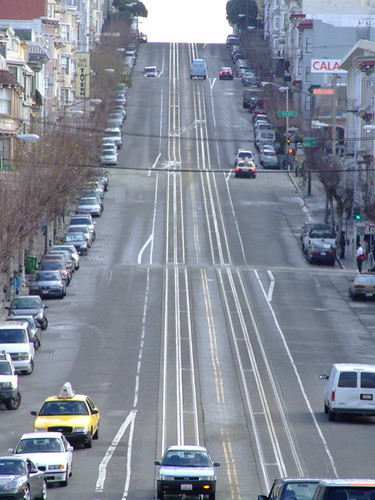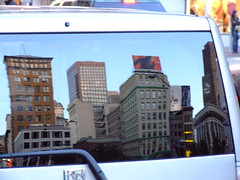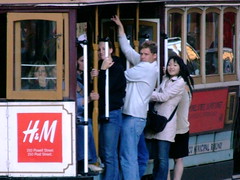San Francisco's parking proposals designed to disconnect suburban (car-oriented) thinking from downtown housing
 California Street, San Francisco. Photos in this entry by Itinerant.
California Street, San Francisco. Photos in this entry by Itinerant.Just a little over two years ago, in response to the Mayor's proposal to attract 100,000 new residents, I wrote something in themail that started like this:
The whole point about a city, if you are truly committed to the pedestrian-based urban experience, is to not be automobile-dependent. I would never expect to be able to park in Fells Point or Little Italy (or Georgetown or Dupont Circle) on a Friday or Saturday night, unless I got there early. I would use other city-friendly forms of transportation. This leads to something that concerns me about the Mayor's campaign to attract 100,000 more residents to the City. Obviously, attracting more residents to the city is something we need to do for many reasons -- to increase income tax revenues, to provide more residents -- eyes on the street -- to help stabilize various areas of the city, to provide more people clamoring for high-quality municipal services, etc. But I have some concerns.
One of those concerns was urban vs. suburban thinking about City Living:
Second, if we attract 100,000 people that want to drive and park a car everywhere, rather than walking places and/or public transportation or other forms such as bicycling, then we will be destroying the quality of life of our city. In other words, if we attract 70,000 new households with 105,000 or so more vehicles clogging our streets (especially SUVs which take up about 1.5 parking spaces compared to regularly sized cars), owned by people who believe that it is their right and privilege to drive and park their vehicles in the public space — for free — we may well ruin the character of our city. Let's not suburbanize Washington, DC!
Enhancing public transportation in all ways should be the foundation of the “City Living” campaign — enhanced bus services (including maps and marketing), the reinsertion of trolleys in major transportation corridors, continued expansion of heavy rail and the creation of “infill” stations, requiring office buildings to develop transportation demand management programs (like Arlington County), support of Metrochek, etc. -- are a piece of the puzzle.
A “transit city” must keep growing its transportation infrastructure and expanding pro-transit policies and development. If we cede the city to the car, then we will give up all that makes the city livable.
 Reflection in Union Square, San Francisco.
Reflection in Union Square, San Francisco.Today, in the San Francisco Chronicle, the article "Supes to consider limit on parking spaces at new buildings: Residential projects in downtown area would be affected," discusses the proposal to be voted on today to reduce parking requirements in the downtown, in order to discourage automobile use in an area where the addition of even a small number of cars exceeds the capacity of choke points in the road network.
From the article:
The legislation, sponsored by Board of Supervisors President Aaron Peskin, who represents parts of the city's downtown, would impose limits where there are none on the number of parking spaces included in new residential buildings.
On Monday, Peskin said the legislation is intended to cut congestion in an area that has convenient access to public transportation. "This is the best-served area by public transportation in San Francisco, bar none," Peskin said. "You can only jam so many cars into a small amount of space, and then you get to the point where you're clogging up streets and nobody's going to want to go downtown." ...
The measure would eliminate minimum parking requirements for downtown residential projects. It would cap the maximum number of spaces allowed in new residential buildings at a level of three-fourths of a parking space for each new unit of housing constructed.
The ordinance would limit above-ground parking to one level, but only if it is buffered by commercial uses along all parts of the building that face the street. It would also establish requirements for bicycle parking and car-share parking spaces in new housing projects.
Buildings larger than 1,000 square feet with two or more bedrooms -- potentially homes for families -- would have an exemption on the maximum spaces allowed and could have up to one parking space per dwelling unit.
 MUNI Transit in San Francisco.
MUNI Transit in San Francisco.
 Cable Car.
Cable Car.Index Keywords: parking



0 Comments:
Post a Comment
<< Home